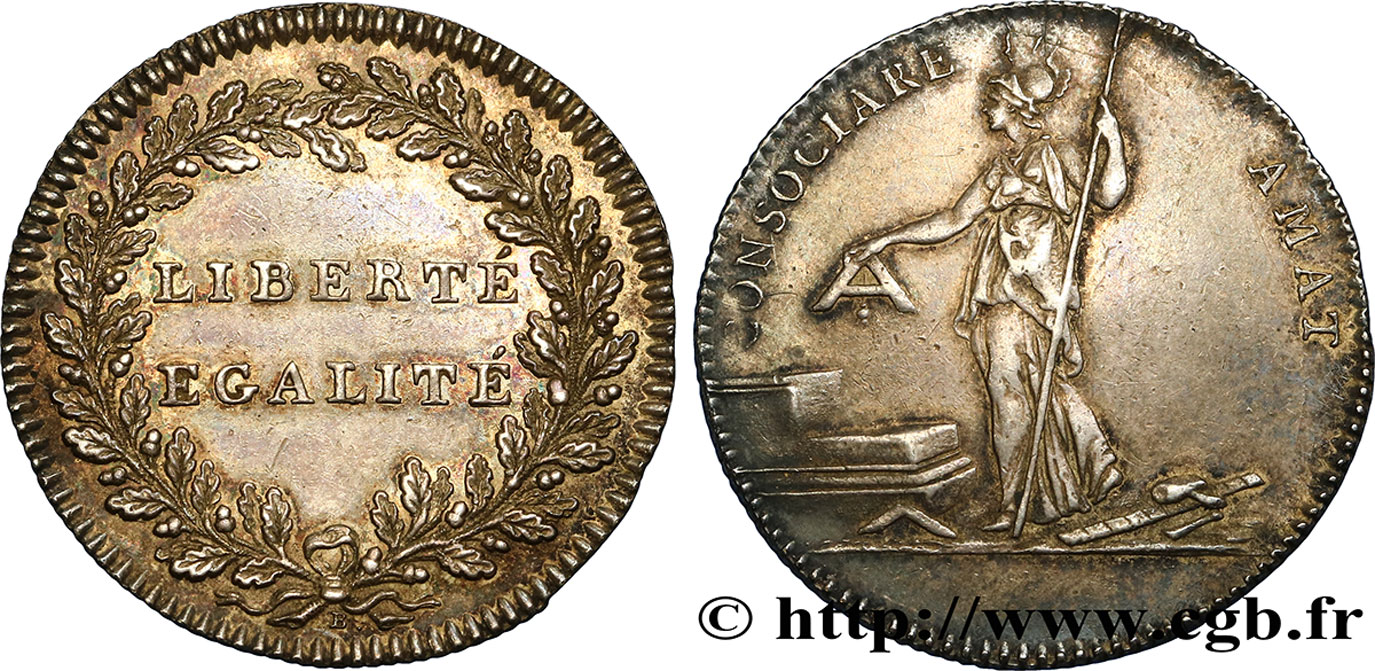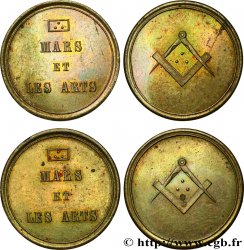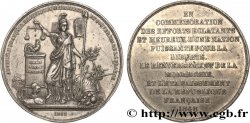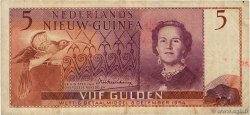E-auction 134-74954 - fjt_05627 - FRANC-MAÇONNERIE - PARIS LOGE LES AMIS DE LA LIBERTÉ n.d.
Sie müssen angeschlossen sein und von cgb.fr genehmigt werden, um in einer E-Auktion teilzunehmen.Melden Sie sich an, um zu wetten..Die Kontobestätigungen sind innerhalb von 48 Stunden nach Ihrer Anmeldung gemacht.Warten Sie nicht bis die letzten zwei Tage vor dem Abschluss eines Verkaufs, um Ihre Registrierung abzuschließen. Klickend "BIETEN" verpflichten Sie sich vertraglich, diesen Artikel zu kaufen und Sie nehmen ohne Reserve die allgemeinen Verkaufsbedingungen für den e-auctions zu cgb.fr an.
Der Verkauf wird an der Zeit auf der Übersichtsseite angezeigt geschlossen werden. Angebote, die nach der Schließung Zeit empfangen sind, werden nicht gültig.
Bitte beachten Sie, dass die Fristen für die Einreichung Ihres Angebots auf unsere Server können variieren und es kann zur Ablehnung Ihres Angebots entstehen, wenn es in den letzten Sekunden des Verkaufs gesendet wird. Die Angebote sollen mit ganzer Zahl ausgeführt sein, Sie können Kommas oder des Punktes in Ihrem Angebot nicht erfassen. Bei Fragen klicken Sie hier, um einen Blick auf die FAQ E-Auktionen.
KEINE ANSCHAFFUNGSKOSTEN FÜR DIE KÄUFER.
KEINE ANSCHAFFUNGSKOSTEN FÜR DIE KÄUFER.
| Schätzung : | 160 € |
| Preis : | 43 € |
| Höchstgebot : | 67 € |
| Verkaufsende : | 09 November 2015 18:34:30 |
| Bieter : | 8 Bieter |
Type : LOGE LES AMIS DE LA LIBERTÉ
Datum: n.d.
Metall : Silber
Durchmesser : 29 mm
Rand cannelée
Seltenheitsgrad : R1
N° im Nachschlagewerk :
Vorderseite
Titulatur der Vorderseite LIBERTE. EGALITE.
Beschreibung Vorderseite Inscription en deux lignes dans une couronne de chêne.
Rückseite
Titulatur der Rückseite CONSOCIARE AMAT.
Beschreibung Rückseite Pallas casquée à droite avec cimier, debout à gauche, tenant un niveau et une lance.
Übersetzung der Rückseite Elle aime à unir.
Kommentare
Le passage de la série au portrait royal à ce nouveau type est du même ordre que le glissement de l’écu royal à la pièce de 5 francs Union et Force. Le portrait du souverain finit remplacé par un symbole, ici un simple slogan.
Il existe avec cet avers, de même coin également signé B., un jeton qui reprend le dernier revers avec la légende IUSTUM. RECTUMQUE. TUETUR (Elle protège ce qui est juste et droit) de la série Justice de Feuardent (après le Feuardent 346).
La légende de revers est extraite des Odes d'Horace (4.II, od.3, v.10). Ce jeton, qui reprend, en lui supprimant son exergue et sa date, un revers de la série des bâtiments du Roi, a été utilisé comme "jeton banal" par des loges maçonniques trop pauvres pour faire frapper leurs propres jetons. Il est aussi attribué sans preuve aux architectes.
L’analyse de Marc Labouret, qu’il n’y a aucune raison de ne pas suivre, l’attribue à la Loge Les Amis de la Liberté.
La franc-maçonnerie s’implante en France aux alentours du premier quart du XVIIIe s. sous l’influence d’aristocrates anglais. Initiatique, elle est fondée sur le rite hiramique, du nom d’Hiram de Tyr, personnage biblique, architecte du roi Salomon sur le chantier du Temple et qui a résisté à la torture sans livrer ses secrets. Hiram a aussi donné un point de départ du calendrier maçonnique commençant 4000 ans avant le calendrier chrétien. Les symboles servent de signes de reconnaissance entre les initiés, notamment des outils de constructeur de cathédrales (équerre, compas, niveau, maillet, etc.), des formes (triangle, étoile), des nombres (trois, cinq, sept) et des lettres.
The transition from the royal portrait series to this new type is of the same order as the shift from the royal shield to the 5 franc Union et Force coin.. The portrait of the sovereign is eventually replaced by a symbol, here a simple slogan.
It exists with this obverse, from the same die also signed B. , a token which takes up the last reverse with the legend IUSTUM. RECTUMCH. TUETUR (She protects what is just and right) from the Justice series by Feuardent (after Feuardent 346).
The reverse legend is taken from the Odes of Horace (4. II, od. 3, v. 10). This token, which, without its exergue and date, is a reverse of the series of the King's buildings, was used as a \\\"banal token\\\" by Masonic lodges too poor to have their own tokens struck.. It is also attributed without proof to architects.
Marc Labouret's analysis, which there is no reason not to follow, attributes it to the Lodge Les Amis de la Liberté.
Freemasonry was established in France around the first quarter of the 18th century.. under the influence of English aristocrats. Initiatory, it is based on the Hiramic rite, named after Hiram of Tyre, a biblical character, architect of King Solomon on the construction site of the Temple and who resisted torture without revealing his secrets.. Hiram also gave a starting point for the Masonic calendar beginning 4000 years before the Christian calendar. Symbols serve as signs of recognition between initiates, including cathedral builder tools (square, compass, level, mallet, etc.). ), shapes (triangle, star), numbers (three, five, seven) and letters
Il existe avec cet avers, de même coin également signé B., un jeton qui reprend le dernier revers avec la légende IUSTUM. RECTUMQUE. TUETUR (Elle protège ce qui est juste et droit) de la série Justice de Feuardent (après le Feuardent 346).
La légende de revers est extraite des Odes d'Horace (4.II, od.3, v.10). Ce jeton, qui reprend, en lui supprimant son exergue et sa date, un revers de la série des bâtiments du Roi, a été utilisé comme "jeton banal" par des loges maçonniques trop pauvres pour faire frapper leurs propres jetons. Il est aussi attribué sans preuve aux architectes.
L’analyse de Marc Labouret, qu’il n’y a aucune raison de ne pas suivre, l’attribue à la Loge Les Amis de la Liberté.
La franc-maçonnerie s’implante en France aux alentours du premier quart du XVIIIe s. sous l’influence d’aristocrates anglais. Initiatique, elle est fondée sur le rite hiramique, du nom d’Hiram de Tyr, personnage biblique, architecte du roi Salomon sur le chantier du Temple et qui a résisté à la torture sans livrer ses secrets. Hiram a aussi donné un point de départ du calendrier maçonnique commençant 4000 ans avant le calendrier chrétien. Les symboles servent de signes de reconnaissance entre les initiés, notamment des outils de constructeur de cathédrales (équerre, compas, niveau, maillet, etc.), des formes (triangle, étoile), des nombres (trois, cinq, sept) et des lettres.
The transition from the royal portrait series to this new type is of the same order as the shift from the royal shield to the 5 franc Union et Force coin.. The portrait of the sovereign is eventually replaced by a symbol, here a simple slogan.
It exists with this obverse, from the same die also signed B. , a token which takes up the last reverse with the legend IUSTUM. RECTUMCH. TUETUR (She protects what is just and right) from the Justice series by Feuardent (after Feuardent 346).
The reverse legend is taken from the Odes of Horace (4. II, od. 3, v. 10). This token, which, without its exergue and date, is a reverse of the series of the King's buildings, was used as a \\\"banal token\\\" by Masonic lodges too poor to have their own tokens struck.. It is also attributed without proof to architects.
Marc Labouret's analysis, which there is no reason not to follow, attributes it to the Lodge Les Amis de la Liberté.
Freemasonry was established in France around the first quarter of the 18th century.. under the influence of English aristocrats. Initiatory, it is based on the Hiramic rite, named after Hiram of Tyre, a biblical character, architect of King Solomon on the construction site of the Temple and who resisted torture without revealing his secrets.. Hiram also gave a starting point for the Masonic calendar beginning 4000 years before the Christian calendar. Symbols serve as signs of recognition between initiates, including cathedral builder tools (square, compass, level, mallet, etc.). ), shapes (triangle, star), numbers (three, five, seven) and letters








 Berichten über einen Fehler
Berichten über einen Fehler Die Seite drucken
Die Seite drucken Teilen meiner Auswahl
Teilen meiner Auswahl Stellen Sie eine Frage
Stellen Sie eine Frage Einlieferung/Verkauf
Einlieferung/Verkauf
 Details
Details















